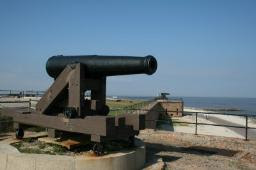| Cannon at Fort Gaines, Alabama |
Born during the American Revolution, Gaines was a hero of the War of 1812 who also fought in the First and Second Seminole Wars and the Mexican War. Along the way, he was the officer who arrested fugitive former U.S. Vice President Aaron Burr in Alabama in 1807.
Gaines was at the pinnacle of his military fame in 1819 when the U.S. Government began construction of a fort on the east end of Dauphin Island. One of two major defenses designed to protect Mobile Bay from foreign attack, the masonry citadel was named in honor of the major general. Gaines died in 1849 and was buried in Mobile's Church Street Graveyard. Fort Gaines, however, continues to stand to this day.
| Fort Gaines |
Confederates completed the fort in 1862 and manned it as one of their key defenses against a Union attack on Mobile Bay. That attack came in August of 1864, when 1,500 Union soldiers landed on Dauphin Island and began their advance on Fort Gaines. Confederate troops skirmished with them as they slowly advanced, before falling back into the defenses of the main fort itself.
| Fort Gaines |
The soldiers in Fort Gaines bore witness as the famed Confederate ironclad C.S.S. Tennessee steamed out to engage Farragut's fleet in one of the greatest ship to ship battles of all time. The Tennessee was eventually captured and the fort held out only another three days, as Union ironclads moved up to point blank range and bombarded its masonry walls. The white flag rose over Fort Gaines on August 8, 1864.
The history of the old fort continued, but never again would U.S. possession of Dauphin Island be contested. Now a historic site maintained by the Dauphin Island Park and Beach Board, Fort Gaines is open to the public daily. To learn more, please visit www.exploresouthernhistory.com/fortgainesal.


